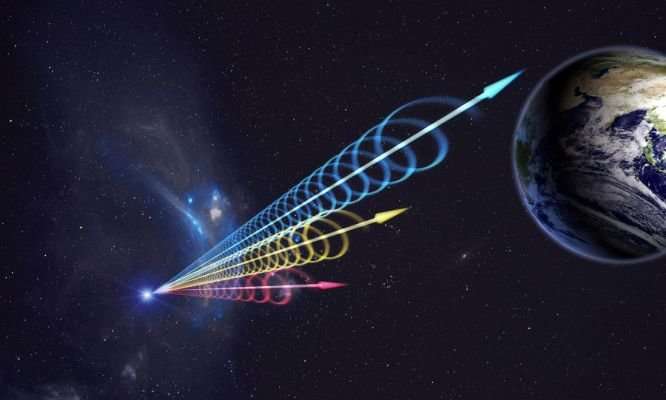BY SINTIA JIMENEZ
Photo from phys.org
Scientists discovered a set of recurring radio bursts from outer space. Fast Radio Bursts (FBRs) are brief (only a few milliseconds) bursts of radio waves coming from far beyond our Milky Way galaxy. According to the CHIME experiment website, it is estimated that these bursts are arriving over Earth about a thousand times per day over the entire sky. These are millisecond-long blips temporarily outshining radio pulsars in our galaxy despite being perhaps a million times farther away.
These signals are very interesting because they are very short. FRBs last only a thousandth of a second or so, any object producing them couldn’t be much bigger than 200 miles across — the distance radio waves can cover in that time. This suggests that the source is considerably smaller than an ordinary star.
Radio bursts have enough energy packed into them to power the world for three centuries. Harnessing this energy would be game-changing for the future of our planet.
In an article for NBC News, Dr. Seth Shostak a Senior Astronomer at the SETI Institute in Mountain View, California states that of the known detected FRBs, FRB 121102 has been observed to repeat and has been shown to come from a small dwarf galaxy at redshift 0.2. A redshift occurs when objects move very fast and the wavelength signal increases due to a property called Doppler Shift. Whether all FRBs repeat and/or are in dwarf galaxies is yet unknown.
The objects were found with the Canadian Hydrogen Intensity Mapping Experiment, or CHIME. This unusual-looking radio telescope, about the size of a football field, consists of four metal mesh cylinders — like skateboard half-pipes — that collect and focus incoming radio waves. CHIME is in a sparsely populated, mountainous region of British Columbia about 30 miles north of the U.S. border.
CHIME consists of four adjacent 20m x 100m cylindrical reflectors oriented north-south. The focal axis of each cylinder is lined with 256 dual-polarization antennas, each of which receives radiation from a large swath of sky that nearly stretches from the northern horizon to the southern horizon. This gives CHIME its enormous field of view. The CHIME antennas are custom-designed to have good sensitivity from 400 to 800 MHz, in both linear polarizations. This gives CHIME its large frequency coverage.
Signals from the antennas are amplified in two stages, using low-noise amplifiers developed by the cell-phone industry. This novel application of consumer technology makes CHIME affordable. The 2048 signals from these inputs (256 antennas x 2 polarizations x 4 cylinders) are fed to the F-Engine for the initial stage of digital processing.
For more information about Fast Radio Bursts and the CHIME telescope please visit the CHIME Experiment website. More images and information about the experiment can be found there. Additional References:
https://www.seti.org/fast-radio-bursts-space-have-baffled-scientists-years-explanation-may-come-soon
https://www.quantamagazine.org/astronomers-now-think-they-can-explain-fast-radio-bursts-20190228/

